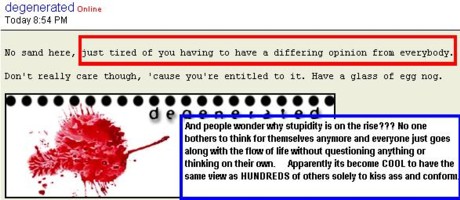Volt wrote:Nickelin Dimer wrote:Mandrel-bends aside... As I've learned (The hard-way) anything larger than 2-1/4" on an otherwise internally-stock LN2 will just cause the flow of gases to just "stall-out" and hurt performance as they back-up in the pipe & crash into each-other, causing even more noise.
It's about matching the flow of the system to the realistically calculated amount of power expected to be produced by the engine... Not just bolting-on some assembly & expecting the miraculous result of the claimed max-gain seen. C'mon....
2.2cfm=1hp@10.5"hg: That's the rule, no-fail.
People seem to be split on this. Ive only seen one dyno test that tests the 2.25 against the 2.5 and it shows that 2.5 is the way to go. granted its from a company that makes a 2.5 exhaust but there are also people who have had both size exhausts and claim there isnt much difference between the two. I have a ton of trouble finding anything that proves 2.25 is better aside from a handful of people making that claim. the again Im no expert myself but if you have any evidence to back that up i would very much like to see it as i am about to put a custom exhaust on my sunfire.
For starters, you posted a dyno test of a 2.4L....where as if i remember correctly, the poster you quoted above said LN2, which is the 2.2OHV 
so right off the bat, you are comparing two engines of different power levels which probably explains the difference of view.
one engine was 115hp or 86-90ish to the wheels 135 tq(LN2) where as the 2.4L engine being a next gen 2.3L HO creation was 150 hp and around 137-144 to the wheels.155 tq(LD9) havent been here in a while so my numbers should be on point, but may be off... goin off memory here, so bear with me.
as an example, 2.5inch on the V8's in the charger have proven to be ok, but there are still many guys running cammed 392's...intake, headers, and pushing 440+ to the wheels running dual 2.25 inch exhaust from Zoomers and also two of em have set records in their class at laguna seca and willow springs. funny part is guys with the same mods, but different exhaust always posting, what can i do different. but they dont wanna get rid of the 2.5 or 2.75 exhaust cause it sounds agressive??? do you wanna sound agressive, or BE agressive in performance terms?
with the cavalier it was and still is no different .
heres some basic guidelines.
from Flowmasters site:
Quote:
The size of tubing used in an exhaust system is a critical item to consider. Tubing diameter will affect the sound level and performance characteristics of the muffler, but keep in mind that bigger is not always better. Using tubing that is too large can actually hinder exhaust scavenging by slowing the velocity of exhaust pulses in the tubing. As a rule, most mildstreet applications (V8 dual exhaust) use 2.00” through 2.25” tubing, and modified street applications (V8 dual exhaust) will generally use 2.25” or 2.50” tubing. Very rarely will 3.00” tubing be used for (dual exhaust) street applications. In general, the following guidelines should be applied for street applications. Remember, these are general guidelines only and specialized applications may differ somewhat. For more specific information please contact Flowmasters tech department.
Tubing Size---- Dual Exhaust ------Single Exhaust
2.00” -------------up to 200 HP -------up to 100 HP
2.25” -------------up to 325 HP -------up to 160 HP
2.50” -------------up to 500 HP -------up to 250 HP
3.00” -------------up to 600 HP -------up to 300 HP
http://www.flowmastermufflers.com/index.php?page=54
if you wanna take magnaflows view on it?
Quote:
Question: Why ISN'T a bigger pipe always better?
Answer: Don't be fooled! Bigger is not better! Many people think that having the biggest diameter pipe is the best way to make power.
Not true. Due to a variety of factors, extensive testing is required. We've dyno'd extensively and our systems yield optimum power increases. Some manufacturers claim even higher horsepower numbers.
It is a fine line to reduce backpressure while maintaining good exhaust velocity. It is not about getting the biggest pipe, it is about getting a more efficient pipe diameter while maintaining exhaust velocity.
There has to be a balanced design to enhance the maximum engine output, exhaust gas velocity, and sound. For example, imagine blowing air through a straw (comparing it to a smaller diameter pipe). This would take time to release all the air from your mouth, and you would feel pressure in your mouth while doing so. Now imagine blowing air through a paper towel roll (comparing it to a larger diameter pipe). You will relieve all your air much faster and feel little or no air pressure in your mouth because of the larger capacity of the tube. This is why it is important to get the correct size piping in order to relieve backpressure while maintaining thermal efficiency.
Use the guide below when calculating pipe size for custom exhaust work. Keep in mind that the goal is to improve exhaust flow. In most cases, just changing the restrictive OEM muffler and replacing it with the same size straight-through, Wide Open Performance MagnaFlow muffler will do the job.
To reduce additional backpressure, the OEM exhaust tubing can be replaced with mandrel-bent tubing of the same size or one size up from the OEM. As a general rule, you can enlarge the pipe diameter of your OEM exhaust system by 1/4 to 1/2-inch to increase your horsepower. However, any additional increase in pipe diameter is likely to decrease your performance; specifically, low end torque.
ENGINE SIZE ------------HORSEPOWER -------MUFFLER INLET/OUTLET
_______________________________Single Exhaust ------------Dual Exhaust
150-200 CID -----------------100 to 150 --------2" to 2-1/4"--------------------- 2"
200-250 CID -----------------100 to 200 --------2-1/4" to 2-1/2" -----------2" to 2-1/4"
http://www.magnaflow.com/07techtips/faq/question10.asp
now i can sit here for days and rehash all the stuff i've posted over the last decade from companies who've spent MILLIONS doing the testing and R&D, but on forums it seems like many will just take the local "whoever" who says "well i felt this in my car" according to a butt dyno. this forum is really no different than any other. just a part of life.
for those who DO use pipe sizes too large, and actually lose power in the lower rpms, and then it picks up in the upper rpms, more times than naught, if you had less to start with off the line, OF COURSE there will be a feeling of a HUGE gain in the upper rpms....
but realistically in a race if you lost time and ground off the line, then making it back up at the end = next to impossible without some additive, boost, nitrous, etc...
if you build your exhaust correctly the first time around, you get off the line quick, and keep pulling till you let off...just the way it is...
another rule of thumb to think about... most of the top end companies have spent thousands if not millions doing the ground work and r&d on this... so they already know something. easiest and cheapest way to do an exhaust.....? CHEAT! use what they spent cash on testing and designing, and replicate it locally. crappy thing to say, but if you can buy the parts and have a friend replicate it for 100-200$ less.... why not? just common sense. some might not want the hassle of buying individual parts or trust the local shop not to mess it up with bad welding or crappy crush or crimp bent pipes...understandable. but some areas have mandrel bending locally and good welders... just sayin.
Nickle and Dimer is correct... on a LN2, which is the 2.2OHV (my 1999 that i still own with 160,000+ miles and still runnin)..... in stock form, this car barely pushes 86-93 FWD HP.... and its rated at 115 hp to the crank. putting 2.5 exhaust on said car would be more of an ego thing than performance. modded with basic boltons the highest most anyone has gotten was around 126-140 hp to the wheels. full engine build you're still only lookin at 150-165 to the wheels.... and if you follow the guidelines...it still puts you in the 2.25 inch range.
magnaflows gives you a bit more range, but it also has a larger range of up to 200hp, instead of the 160 as flowmaster is more precise.
theres proof all over out there. when i was actually on the forums consistently, there were dyno sheets every month, and even WITH proof, you still had the guys who spoke against it saying 2.5 was the way to go.... went out put on 2.5, and had every excuse in the book why they lost power: exhaust leaks, lifter collapsed, headers leaking, intake filter dirty and couldnt clean it for 2-4 months, worn wheel bearings causing drag but worked ok when up to speed..... the list would be 1-2 paragraphs long. legit.
in the end, you dont have to take my advice, or anyone elses, but my main advice, do the research. the companies have already done it, and the LN2 really hasnt changed much....so pretty much everything here is accurate and remains constant. this day and age, most people WILL NOT take the time to call around to major exhaust companies, or suspension, performance, and get facts. but they will listen to the guy on the forum whos always repairing stuff broken and not working out for him or her on their car. theres really no wrong way to do things, but the people that do it right the first time, spend more time enjoying their car than wrenching on it....ESPECIALLY STREET CAR where you are NOT racing spending 50-70k per year to stay competitive.


















